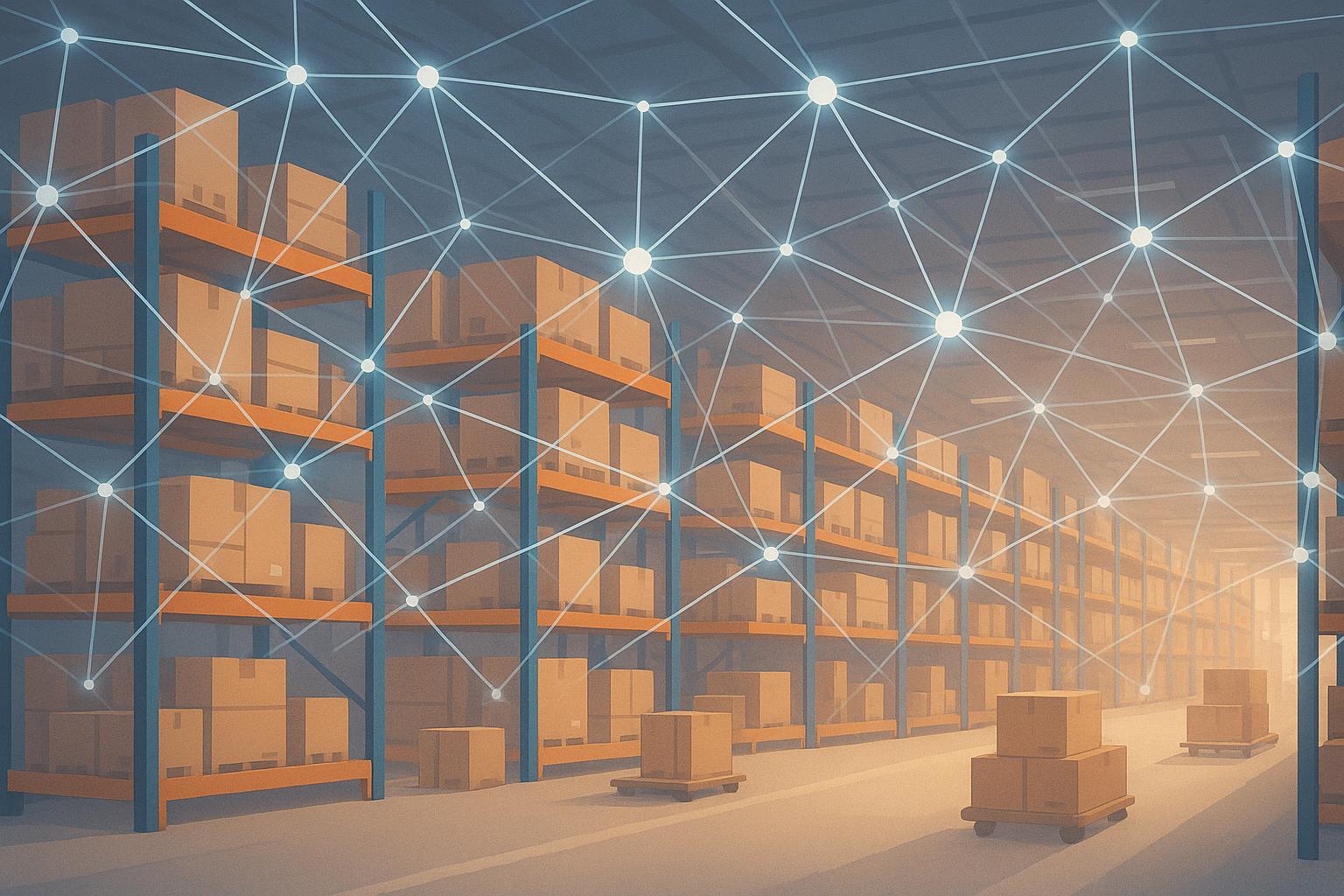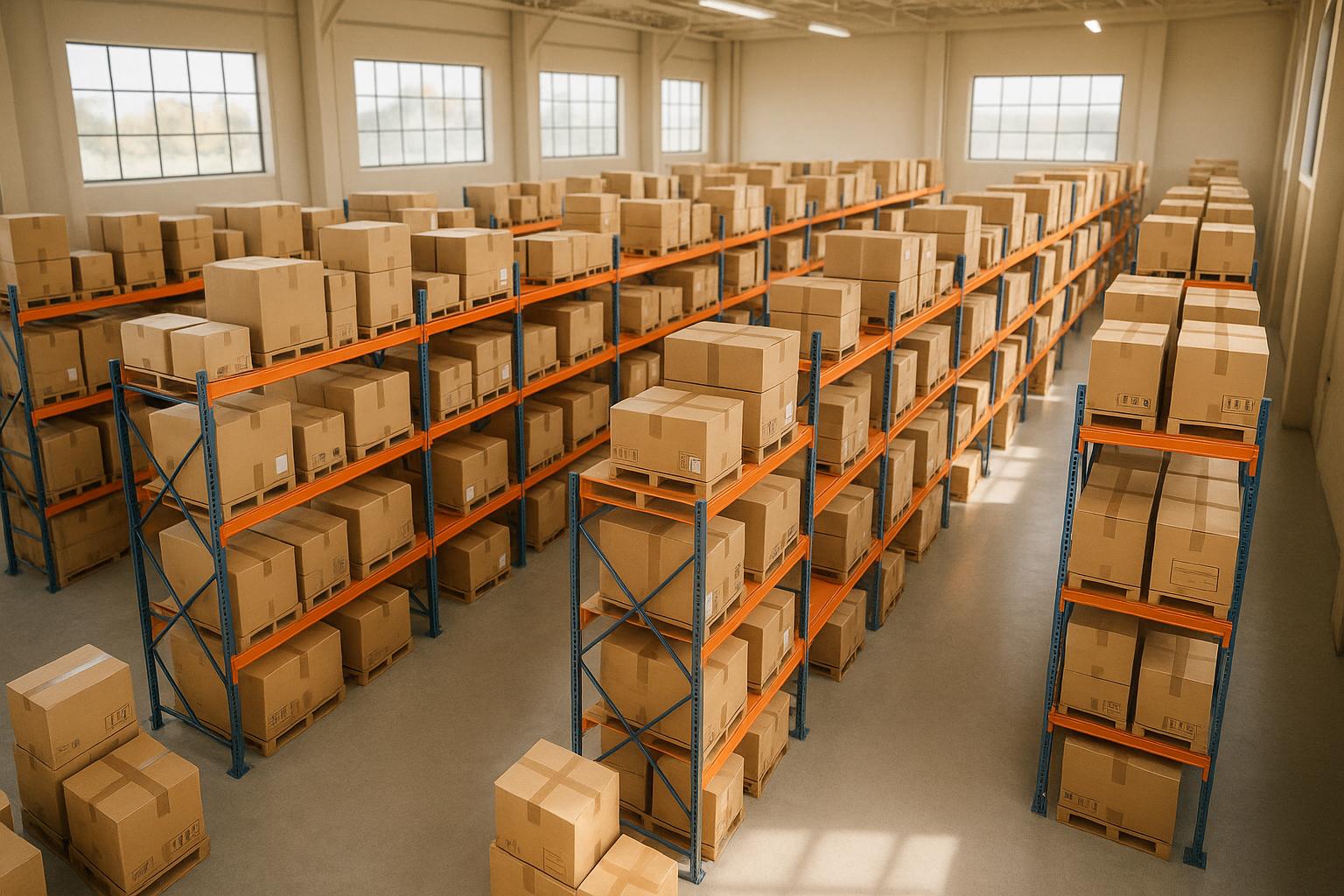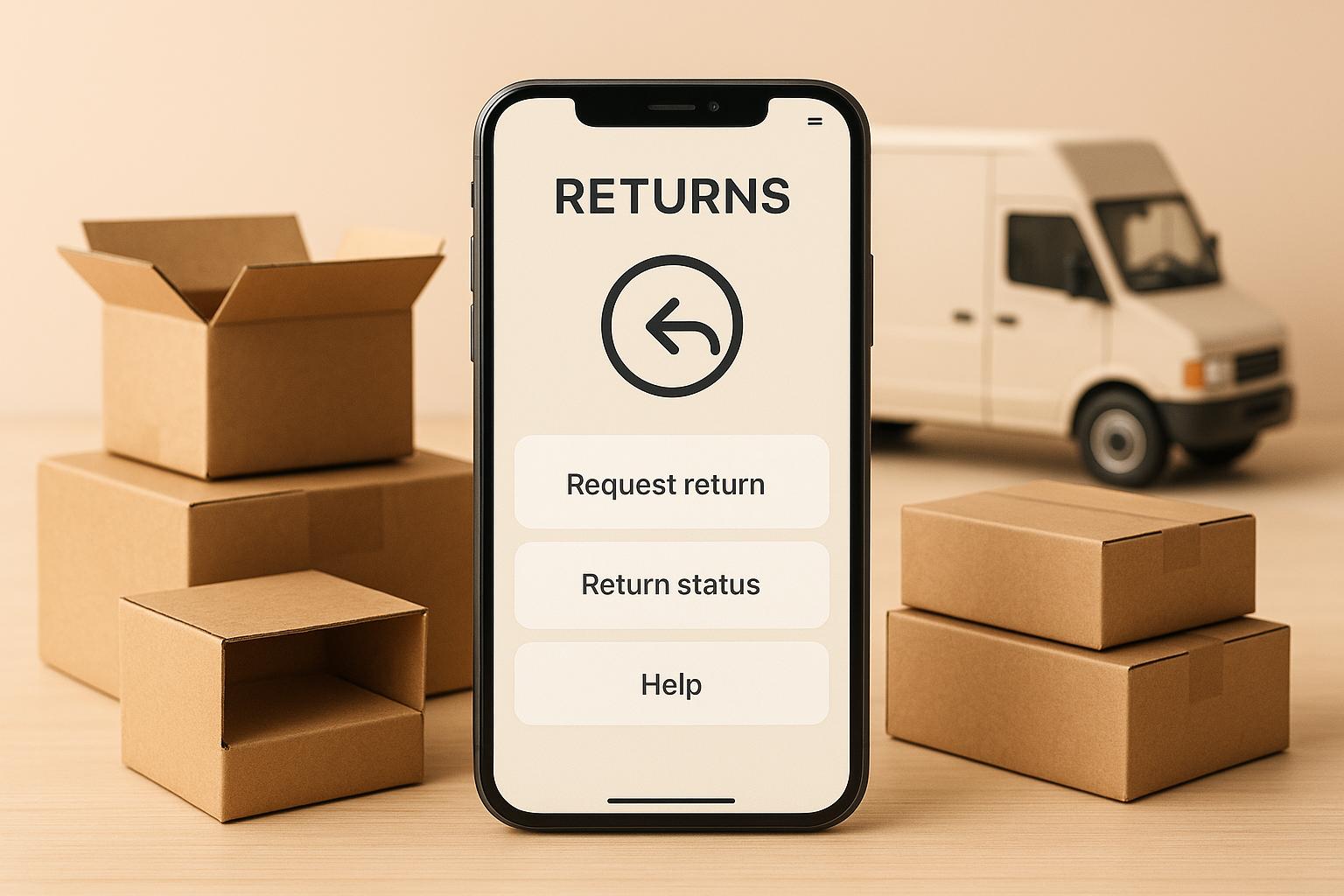Best Practices for 3PL Cyber Risk Management

Cyber threats are a growing problem for third-party logistics (3PL) providers. These companies handle sensitive data, manage interconnected systems, and rely on real-time operations - making them prime targets for cyberattacks. Key risks include ransomware, phishing, supply chain vulnerabilities, and weak IoT security. A single breach can halt operations, expose client data, and damage reputations.
Key Takeaways:
- Major Risks: Ransomware, phishing, outdated software, and IoT vulnerabilities.
- Impact: Shipment delays, financial losses, and client trust issues.
- Solutions: Regular audits, strong access controls, employee training, and advanced tools like intrusion detection and AI-based threat detection.
- Compliance Needs: Regulations like GDPR and CCPA require strict data protection measures.
Why It Matters: 3PL providers must prioritize cybersecurity to safeguard operations, comply with laws, and maintain client trust. This article outlines practical steps to strengthen defenses and reduce risks.
The 5 Most Important Third-Party Cyber Risks To Track - And Why
Common Cyber Risks in 3PL Operations
Third-party logistics (3PL) providers navigate a maze of cyber threats that can disrupt their operations, compromise sensitive data, and strain client relationships. Recognizing these risks is a crucial step toward building stronger defenses.
Supply Chain Attacks and Vendor Weaknesses
The interconnected nature of 3PL networks makes them a prime target for supply chain attacks. Cybercriminals often exploit vulnerabilities in vendors’ systems - whether it’s in cargo booking, last-mile courier services, or customs operations. These breaches can stem from compromised software, outdated systems, or insecure hardware setups.
For instance, a breach at a smaller vendor with access to inventory systems can open the door for attackers to manipulate shipment data or steal sensitive client information. Once inside, attackers might move laterally through connected systems, potentially compromising multiple clients’ data and operations. The ripple effects of such breaches can be catastrophic.
To mitigate these risks, it’s essential to monitor and update all integration points, such as those with platforms like Shopify, NetSuite, and ShipStation. Keeping these systems patched ensures a consistent security baseline across all partners.
Ransomware, Phishing, and Malware
Ransomware attacks do more than just steal or encrypt data - they can bring physical operations to a grinding halt. Trucks sit idle, support teams are locked out, and orders are canceled, leading to financial losses and damage to a company’s reputation. For ecommerce and retail clients, this can mean refund demands and a serious blow to customer trust.
Phishing, on the other hand, targets human error. Under the stress of tight schedules, drivers or dispatchers may inadvertently click on malicious links, giving attackers the credentials they need to deploy ransomware or malware. Malware often operates in stealth, stealing data or laying the groundwork for future attacks.
IoT and Cloud Security Risks
Emerging technologies like IoT and cloud platforms introduce additional vulnerabilities. IoT devices - such as smart locks, telematics systems, and temperature sensors - often come with default passwords and limited patching capabilities, making them easy targets for hackers. These devices are built for functionality, not security, and can be exploited to falsify critical data, such as temperature readings for perishable goods, potentially leading to spoilage or compliance violations.
Legacy systems, which often rely on outdated software and weak authentication, add to the complexity. The vast number of IoT devices spread across warehouses, vehicles, and distribution centers creates numerous entry points for cybercriminals.
Cloud misconfigurations also pose a significant threat. Weak access controls or poorly configured storage systems can expose sensitive shipment data, leading to compliance violations and a loss of client trust. For example, a misconfigured cloud storage bucket could leave shipment details accessible to anyone on the internet.
Real-time visibility demands, such as minute-by-minute location updates, require token-based APIs and strict access controls. A single leaked credential could expose an entire run sheet, causing widespread disruption.
The interconnected nature of 3PL operations means that vulnerabilities in one area - whether it’s an unsecured IoT device, a misconfigured cloud system, or a successful phishing attempt - can have cascading effects across the entire network, impacting multiple clients and operations simultaneously.
Best Practices for 3PL Cyber Risk Management
Cyber threats are becoming an ever-present challenge for third-party logistics (3PL) providers, targeting everything from warehouse management systems to fleet telematics. To protect operations and maintain a secure supply chain, businesses must adopt effective security practices that create multiple layers of defense against these constantly evolving risks.
Regular Cybersecurity Audits and Vulnerability Assessments
The first step in building a solid cybersecurity strategy is identifying weak points across your systems. Conducting regular vulnerability scans and red-team exercises can reveal gaps in your defenses and help you anticipate potential threats. For instance, scoring each asset based on its likelihood of being attacked and its impact on business operations - using tools like CVSS calculators - can help prioritize what needs immediate attention. A vulnerability in a system handling sensitive customer data, for example, should take precedence over issues in less critical devices.
Independent testers can also uncover problems in older systems that might still rely on outdated protocols or weak authentication. Regular audits can significantly reduce exposure to risks, cutting vulnerabilities by as much as 50%. It's also crucial to evaluate integration points with third-party systems, ensuring all components are patched and secure to prevent attackers from exploiting weaker links in the supply chain. Once vulnerabilities are identified, the next step is to strengthen access controls.
Stronger Access Controls and Authentication
Access control weaknesses are one of the most common ways cybercriminals gain entry into systems. Implementing role-based permissions ensures employees only have access to the specific data they need for their jobs. Adding multi-factor authentication (MFA) for all remote logins - whether by office staff, drivers using mobile apps, or third-party vendors - provides an extra layer of protection.
Credential management is another critical piece of the puzzle. Regularly rotating passwords and promptly revoking access for former employees can significantly enhance security. Adopting the principle of least privilege, where users are granted only the minimum access required, and using token-based APIs with granular controls further reduces the risk of widespread data exposure from a single compromised credential. While technology establishes the boundaries, well-informed employees are key to maintaining them.
Employee Training and Awareness Programs
Human error remains a major cybersecurity vulnerability, especially in fast-paced environments like 3PL operations. Drivers and dispatchers, often working under tight deadlines, can be particularly susceptible to phishing scams that exploit their need to act quickly. Role-specific training tailored to these scenarios can help employees recognize and respond appropriately to potential threats.
Quarterly simulation drills, such as mock ransomware or phishing attacks, are effective in reinforcing proper responses. Keeping training sessions concise, relevant, and grounded in recent examples from the logistics industry makes them more engaging and impactful. By integrating security awareness into performance evaluations, companies can elevate cybersecurity from a compliance task to a core part of their operational culture. This shift ensures that employees actively contribute to a stronger, more secure organization.
sbb-itb-eafa320
Advanced Tools and Technologies for Better Cybersecurity
While strong access controls and employee training are crucial for cybersecurity, advanced tools that enable proactive threat detection and mitigation add an extra layer of defense. These technologies help organizations stay one step ahead of evolving threats.
Intrusion Detection Systems and Real-Time Monitoring
Intrusion Detection Systems (IDS) play a critical role in monitoring network traffic and system activities to identify suspicious behavior or unauthorized access. For 3PL operations that handle complex supply chains and large shipment volumes, IDS act as an early warning system for potential breaches.
Real-time monitoring tools complement IDS by continuously tracking activity across interconnected systems, such as warehouse management platforms and fleet telematics devices. If unusual behavior - like an unexpected login or abnormal data transfer - is detected, these tools issue instant alerts. Security Information and Event Management (SIEM) platforms take this a step further by consolidating logs from endpoints, IoT devices, and cloud systems into a centralized dashboard. This allows for correlated alerts that significantly reduce the time needed to detect and respond to threats.
For instance, a 3PL using IDS and real-time monitoring was able to detect unauthorized access to its cloud systems. The breach was contained immediately, preventing data theft. These tools form the backbone of more advanced technologies that refine and enhance threat detection.
AI and Predictive Analytics for Threat Detection
Artificial intelligence (AI) and predictive analytics transform how threats are identified. By analyzing vast amounts of data, these technologies recognize subtle patterns that might otherwise go unnoticed. For example, they can flag anomalies like a driver’s mobile device accessing unusual network resources or an office computer connecting to unfamiliar servers - potential signs of phishing, malware, or insider threats.
AI’s predictive capabilities shift cybersecurity from a reactive to a preventive approach. By analyzing historical and current threat data, AI systems can forecast potential attacks and suggest measures to avoid them. One company, for example, used AI-powered analytics to identify a ransomware attack in its early stages. The affected systems were isolated, and operations were restored from secure backups, minimizing downtime and financial impact.
Data supports the effectiveness of these technologies: 3PLs that incorporate real-time monitoring and AI-driven threat detection report up to 40% faster incident response times and a 30% decrease in successful cyberattacks compared to those relying on manual methods. Alongside these proactive measures, robust backup systems ensure business continuity when incidents occur.
Data Backup and Disaster Recovery Solutions
Secure data backup and disaster recovery systems are indispensable for maintaining business operations during disruptions. Regularly scheduled, encrypted backups - both on-site and off-site - enable quick recovery from ransomware attacks, system failures, or other interruptions.
Cloud-based backup solutions add scalability and security through features like multi-factor authentication and strong access controls. Isolating backups from primary systems ensures that attackers cannot compromise both operational data and recovery copies.
Equally crucial is testing recovery procedures regularly. Disaster recovery plans should clearly define roles, responsibilities, and step-by-step actions to restore operations after a cyber incident. Periodic drills ensure that every team member is prepared. Well-implemented backup and recovery systems can reduce downtime from several days to just a few hours, which is critical for time-sensitive shipments and meeting client expectations.
Modern backup solutions also assist with compliance by maintaining detailed audit trails and ensuring data integrity during recovery. This provides clients with confidence that their information remains secure, even during incident response.
Building a Strong Cybersecurity Culture in 3PL Organizations
While advanced tools play a key role in technical defenses, they’re only as effective as the people using them. A strong cybersecurity culture ensures these tools are put to good use. For 3PL organizations, this means making cybersecurity a company-wide priority, not just an IT concern. Every department needs to understand its role in protecting the organization, turning cybersecurity into a shared responsibility.
Cross-Functional Collaboration for Cybersecurity
To safeguard 3PL operations, coordination between IT, logistics, and legal teams is essential. Modern fulfillment systems depend on tightly integrated digital platforms, and every connection point needs regular monitoring and updates to stay secure. When departments work in silos, security gaps can arise, creating opportunities for cybercriminals.
IT teams handle the technical side - firewalls, encryption, and other security protocols. Meanwhile, logistics teams bring operational expertise, offering insights into how data flows and integrates across systems. Legal teams ensure compliance with regulations like GDPR and CCPA, helping avoid hefty fines and legal trouble. Regular cross-departmental meetings are crucial for identifying vulnerabilities and updating security measures, ensuring cybersecurity is woven into daily decision-making. This teamwork ensures security becomes a natural part of operations instead of an afterthought.
Integrating Cybersecurity into Daily Operations
Cross-functional collaboration is just the beginning. Cybersecurity works best when it’s baked into everyday workflows, rather than treated as an extra step. For instance, 3PL organizations can use automated monitoring tools and secure authentication processes at every stage of the logistics chain.
Access control is particularly important in warehousing, where data syncing drives the entire order lifecycle. A single oversight could lead to inventory errors or even data breaches. To avoid this, organizations should enforce strong access controls, regular software updates, and real-time monitoring. Advanced systems that establish normal behavior patterns can alert teams only when something unusual happens, striking a balance between security and operational efficiency.
Testing and Updating Incident Response Plans
Even the best security measures need regular testing to ensure they’re effective. Simulation drills, file restoration tests, and hybrid backup strategies are vital for quick recovery and minimizing downtime.
Automated threat detection systems, paired with real-time incident response plans tailored to logistics operations, help teams act swiftly when anomalies arise. These plans should address the specific challenges of ransomware, including inventory disruptions, order delays, data breaches, and reputational risks. Security audits and assessments are also critical, extending to partners and vendors to identify potential weak links in the supply chain.
Conclusion: Maintaining Secure and Efficient 3PL Operations
Cybersecurity has become a critical priority for 3PL providers. With cyber threats targeting manufacturing and transportation industries more frequently, even a single breach can bring operations to a standstill, disrupt workflows, and harm reputations.
Staying ahead of these risks isn't just about protecting data - it’s about ensuring uninterrupted operations and maintaining client confidence in an increasingly interconnected supply chain. Providers who prioritize proactive cyber risk management are better equipped to thrive, while those who don’t risk falling behind. The strategies outlined earlier highlight the importance of adopting a multi-layered approach to defense.
Tactics like vulnerability assessments, strict access controls, and comprehensive employee training are key to staying competitive. Adding tools such as intrusion detection systems, AI-powered threat analysis, and dependable backup systems further strengthens a company's ability to adapt and grow in today’s challenging environment.
Take JIT Transportation as an example. They’ve embraced advanced technology and scalable solutions to set a standard for secure and efficient operations. Their focus on cybersecurity, paired with a nationwide network and additional value-driven services, showcases how strong security measures can seamlessly align with operational excellence to support reliable supply chain management.
FAQs
What steps can 3PL providers take to enhance IoT and cloud security in their operations?
To bolster IoT and cloud security, third-party logistics (3PL) providers can take several important steps:
- Perform frequent security audits to pinpoint vulnerabilities and ensure alignment with industry regulations.
- Implement encryption and secure authentication to safeguard sensitive data both in transit and at rest.
- Educate employees on cybersecurity best practices, minimizing risks tied to human error and phishing attacks.
These steps help 3PL providers safeguard their systems and uphold client trust.
How can 3PL companies use employee training to prevent phishing attacks?
To reduce the risk of phishing attacks in 3PL environments, it's essential to focus on equipping employees with awareness and practical skills. Begin by educating them on common phishing techniques, such as suspicious emails, fake login pages, and misleading links. Help them spot red flags like unexpected requests for sensitive details or messages with urgent or alarming tones.
Support this education with ongoing training sessions and simulated phishing tests to sharpen their ability to identify threats. Encourage employees to report anything suspicious right away, fostering a workplace culture that prioritizes security. Regular training keeps your team prepared to face emerging cyber threats, safeguarding your operations from potential breaches.
How do advanced technologies like AI and predictive analytics help improve cybersecurity for 3PL providers?
Advanced tools like AI and predictive analytics are reshaping cybersecurity for 3PL providers, offering a proactive approach to identifying and addressing threats. AI processes massive amounts of data in real time, spotting unusual patterns or activities that could signal a potential cyberattack. Meanwhile, predictive analytics helps anticipate weaknesses, allowing providers to tackle risks before they escalate into serious problems.
When these technologies are integrated into their systems, 3PL providers gain stronger protection for sensitive data, stay aligned with security standards, and keep supply chain operations running smoothly. Pairing these tools with regular system updates and employee training creates a well-rounded defense against ever-changing cyber threats.
Related Blog Posts
Related Articles

10 Common Supply Chain Risks and How 3PLs Solve Them

9 Ways 3PLs Solve DTC Scalability Problems

